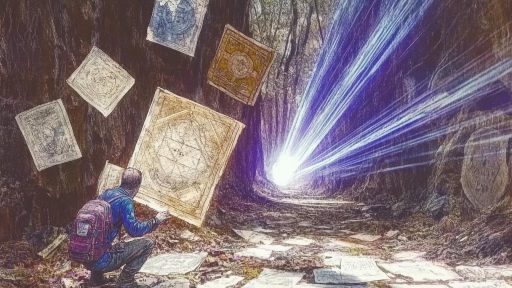
Time is supposed to be constant, linear, and predictable—but the universe has other plans. From strange artifacts in impossible layers of earth to bizarre anomalies that bend the rules of chronology, some discoveries don’t just challenge our understanding of time—they obliterate it. These revelations have left scientists baffled, sparked theories of time travel, and forced us to question the timeline we thought was set in stone. Are these outliers mistakes of nature or glimpses into something far deeper?
The London Hammer

Found embedded in ancient rock in Texas, this 19th-century-style hammer was discovered encased in a layer of Ordovician stone supposedly over 400 million years old. The wooden handle had even begun to turn to coal. Its existence has baffled geologists and sparked theories of temporal anomalies and time travel. How could such a modern object exist inside rock from an era before the dinosaurs?
The Antikythera Mechanism

Often called the world’s first computer, the Antikythera Mechanism was pulled from a Roman-era shipwreck off the coast of Greece. This intricate device, built over 2,000 years ago, could accurately predict astronomical positions and eclipses. Its mechanical complexity rivals that of 18th-century clocks, yet it predates them by more than a millennium. It rewrote everything we thought we knew about ancient technology and their understanding of time.
The Baghdad Battery

This curious artifact consists of a ceramic jar, a copper cylinder, and an iron rod—forming what appears to be a primitive battery. Dated to around 250 BCE, it challenges our assumptions about ancient electrical knowledge. Some believe it may have been used for electroplating or medical therapies. If true, it means early civilizations had a grasp on time-based electrical reactions far earlier than recorded history admits.
The 200-Million-Year-Old Shoe Print

In Utah, a fossilized footprint resembling a modern shoe was reportedly found in Triassic rock, estimated to be over 200 million years old. The print even appears to show the mark of a worn-down heel. While skeptics argue it’s a natural formation, others see it as evidence of time distortion or lost civilizations. Could someone—or something—have walked out of place in time?
The Voynich Manuscript

This mysterious book is written in an unknown language and illustrated with bizarre botanical drawings, astronomical diagrams, and human figures interacting with strange contraptions. Carbon dating places its creation in the early 15th century, but nothing about it matches the science or knowledge of that time. Despite decades of study, no one has been able to decode its contents. It’s as if it comes from a timeline that split from our own.
The Dropa Stones

Discovered in a remote cave in the Bayan Har Mountains of China, these carved stone discs supposedly date back 12,000 years. Each features a spiral groove etched with tiny, mysterious hieroglyphs. Some researchers believe the stones tell the story of ancient visitors from the stars—raising questions about time travel or interdimensional beings. Their origin remains hotly debated and deeply enigmatic.
The Tulli Papyrus

An ancient Egyptian document allegedly describes “circles of fire” in the sky that caused chaos and panic. Some believe it’s the earliest recorded account of UFOs, while others claim it’s a mistranslation. Either way, the timing of the text—dating back thousands of years—challenges our timeline of technology and celestial observation. Is it an omen, a warning, or a temporal echo?
The Swiss Watch in a Sealed Tomb

In 2008, archaeologists opening a 400-year-old sealed tomb in China claimed to find a tiny object resembling a Swiss wristwatch—with the time frozen at 10:06. No explanation has ever fully accounted for its presence. Was it planted? A hoax? Or did something slip through the cracks of time? The watch remains a mystery no timeline can easily explain.
Time Crystal Experiments

In recent years, scientists have created what they call “time crystals”—structures that maintain movement without energy input, defying traditional laws of thermodynamics. They oscillate between configurations in a perpetual loop, hinting at a new phase of matter. If validated, time crystals could radically reshape our understanding of time and entropy. We’re now seeing real experiments that echo science fiction.
The Mystery of the Chronovisor

Allegedly created by Vatican scientists in the 1950s, the Chronovisor was said to be a device that could view past events. Descriptions claim it could display historical scenes like the crucifixion of Christ or ancient Roman ceremonies. Though no physical evidence has surfaced, the story persists—and some believe the Vatican still keeps it hidden. If real, it would be the ultimate time discovery, allowing us to witness history itself.
The Ancient Swiss Watch in a Sealed Tomb

In 2008, archaeologists in China reportedly uncovered a sealed Ming Dynasty tomb—untouched for over 400 years. But what shocked them wasn’t the relics or the craftsmanship; it was a tiny object shaped like a modern wristwatch, with the word “Swiss” engraved on the back. How could such an item exist centuries before watches of that style were invented? Skeptics cried hoax, but the tomb’s sealed nature left a lingering mystery: did something—or someone—from the future drop it there?
What If Time Isn’t What We Think It Is?

We tend to treat time as a fixed, linear progression—but these discoveries suggest otherwise. They hint at loops, ruptures, forgotten knowledge, and anomalies that shake our understanding of cause and effect. Maybe we’ve only scratched the surface of what time truly is. And perhaps the greatest discovery isn’t about when something happened—but why time lets us find it at all.





